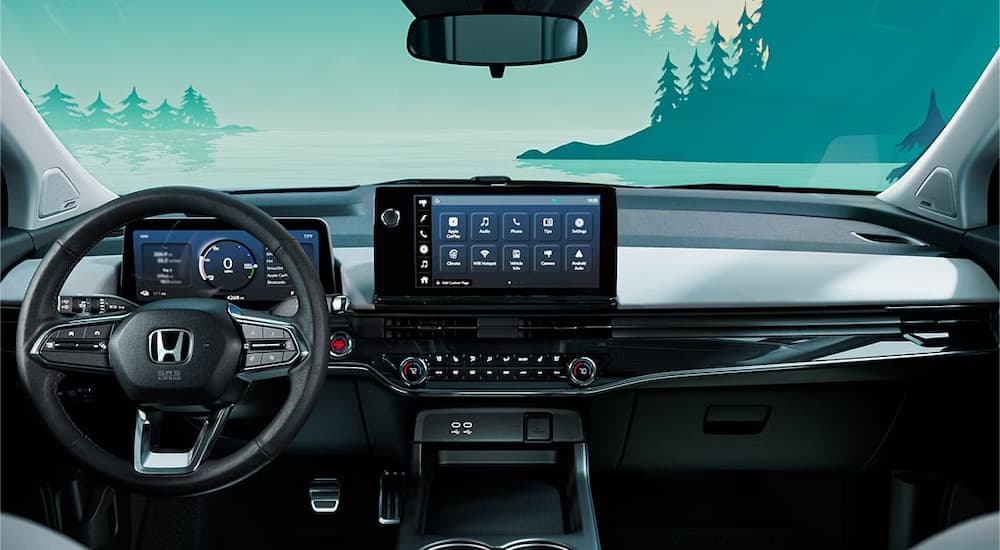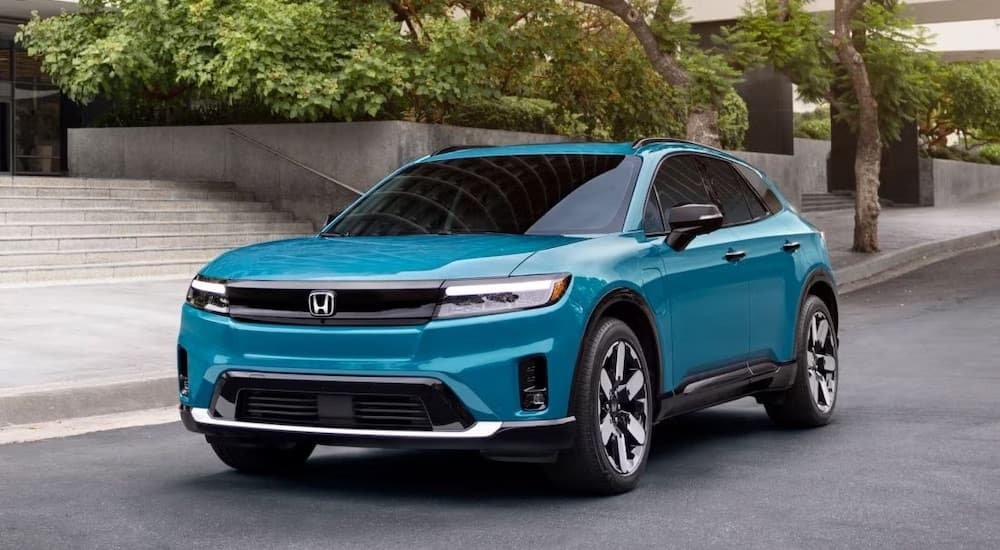When you’re looking for an SUV at your local Honda dealer, you have plenty of options to choose from. If the subcompact HR-V and compact CR-V are too small for your liking and the three-row Pilot is too big, then you’re left with two midsize models: the rugged Passport and the new all-electric Prologue. So, which one should you pick? Let’s take a look at the strengths and drawbacks of each option and see what they have to offer different types of drivers.
Powertrain
We’ll start with perhaps the most obvious difference between the two: the Passport runs on a traditional gas engine while the Prologue is an EV. Specifically, the 2024 Passport comes standard across all trims with a 3.5L V6 engine that produces 280 horsepower and 262 lb-ft of torque, allowing you to tow up to 5,000 lbs. All-wheel drive is also standard, giving you the traction necessary to tackle wet roads and loose surfaces with confidence. The downside to this setup is fuel economy. While the average 2024 vehicle gets 28 MPG, the Passport is rated at just 21 MPG combined.
The Prologue comes standard with an 85 kWh battery that powers either a single motor (front-wheel drive) or a pair of motors (all-wheel drive). The FWD setup is the weaker of the two, producing 212 horsepower and 236 lb-ft of torque, but it is also the most efficient, delivering 99 MPGe and allowing you to drive an estimated 296 miles on a full charge. With AWD, you get 288 horsepower and 333 lb-ft of torque for improved acceleration and driving dynamics, while still getting solid fuel economy and range (an estimated 95 MPGe and 281 miles of range). Neither setup is going to come close to the Passport’s towing capacity, though, since both max out at 1,500 lbs.

Interior
Since the Passport and Prologue are both midsize SUVs, they have fairly similar dimensions: the Prologue is a bit longer, the Passport is a bit taller, and they have practically the same width. Passenger space is pretty similar, with the Prologue offering an extra half inch of front-row legroom and the Passport providing two inches more second-row headroom. The Passport also offers significantly more cargo space behind the back row, thanks to its boxier body and higher roof.
When it comes to infotainment, while both SUVs have a solid array of standard features, the Prologue has the upper hand. The Passport has an eight-inch touchscreen, and while it comes standard with a wireless charging pad, phones need to be physically plugged into the interface for Apple CarPlay and Android Auto to work. The Prologue has a larger 11.3-inch central touchscreen as well as an 11-inch digital instrument cluster behind the wheel, making it easier to read texts at a glance and get a good look at camera views. In addition to wireless charging, the Prologue also comes standard with wireless Apple CarPlay and Android Auto connectivity. On top of that, the EV also has standard Google Built-in, allowing drivers to use Google apps for music streaming, navigation, and more without the need for a smartphone.
While the Prologue’s interior is well-appointed, longtime Honda drivers might find that it takes some getting used to. That’s because the Prologue was built in collaboration with General Motors using the Ultium platform in order to help Honda release an EV in the US earlier than it could have if it had to build its own from the ground up. While Honda designers were able to customize a lot about the interior, they didn’t have free reign. The result is that some things are simply different; for instance, the windshield wiper controls are on the left of the steering wheel rather than the right. If you aren’t loyal to a particular automaker, then this might not affect you at all. But if you’ve been driving Hondas for decades and don’t want to have to re-learn where basic controls are, you might have a better time behind the wheel of the Passport.

Trims
The Prologue and the Passport have three trims each, but those trims are not the same. The entry-level options are somewhat similar, but the Prologue’s EX trim doesn’t have all of the comfort and convenience features standard on the Passport’s EX-L trim. For example, the Passport EX-L features leather-trimmed seats instead of cloth, tri-zone automatic climate control instead of dual-zone, a power tailgate instead of one that needs to be opened manually, and a moonroof. The base Passport EX-L also has a lower starting price than the Prologue EX. However, the difference between the two is about $5,000, so if you get the $7,500 Federal EV tax credit that the Prologue is eligible for, it ends up being the more affordable option at the end of the day.
Upgrade to the Prologue Touring, and you’ll get several of the features the EX is missing, plus a few extras for good measure. The Touring trim features leather-trimmed seats and a power tailgate with hands-free access, as well as a panoramic moonroof and a Bose premium audio system with 12 speakers. On the outside, the Touring gets futuristic welcome lights and roof rails.
Instead of adding additional creature comforts, the mid-level trim of the 2024 Passport goes in an entirely different direction, making the Passport more adventurous. The TrailSport gets an off-road-tuned suspension system that can handle rough terrain, roof rails for holding extra gear, and LED fog lights for dark nights in rural areas. It also has distinctive styling, with orange contrast stitching standing out against the leather seats and all-season floor mats with the TrailSport logo keeping the interior protected.
At the top of the pack, we have the Prologue Elite and the Passport Black Edition. While the Black Edition doesn’t have an off-road-tuned suspension, it does retain many of the TrailSport’s perks, like roof rails and LED fog lights. On top of that, it features ventilated front seats, heated rear seats, hands-free access for the power tailgate, auto-dimming side view mirrors, rain-sensing windshield wipers, and a premium audio system with 10 speakers.
The Prologue Elite comes standard with the more powerful dual-motor all-wheel drive setup and features advanced driver assist features like Rear Pedestrian Alert and a Surround Vision System, which gives you a top-down view of the area around the vehicle. The tech is also improved by the addition of a head-up display, which projects information onto the lower portion of the windshield so you can see it without taking your eyes off the road. The trim also has ventilated front seats and a heated wiper zone to keep you better prepared for extreme weather.
To Each Their Own
While it might seem easy to compare two midsize SUVs from the same brand, things get tricky when they have such different sets of strengths and weaknesses. At the end of the day, it’s less a question of which one is better and more a matter of which one is right for you. For some, this will be an easy choice. If you’re looking to get an efficient SUV that doesn’t burn through fuel, pick the Prologue. If you need high towing capacity or off-road capability, you’ll want to go with the Passport.
If none of those things are your top priority, then you’ll want to look more closely at the details. Little things like how the Prologue doesn’t have heated rear seats and how the Passport doesn’t have wireless smartphone connectivity might be minor considerations to some drivers and deal breakers for others. Hopefully, seeing the differences laid out clearly has helped you lean in one direction or the other. If not, you can always head to your local Honda dealer and take a few test drives to get a feel for which one you prefer.



